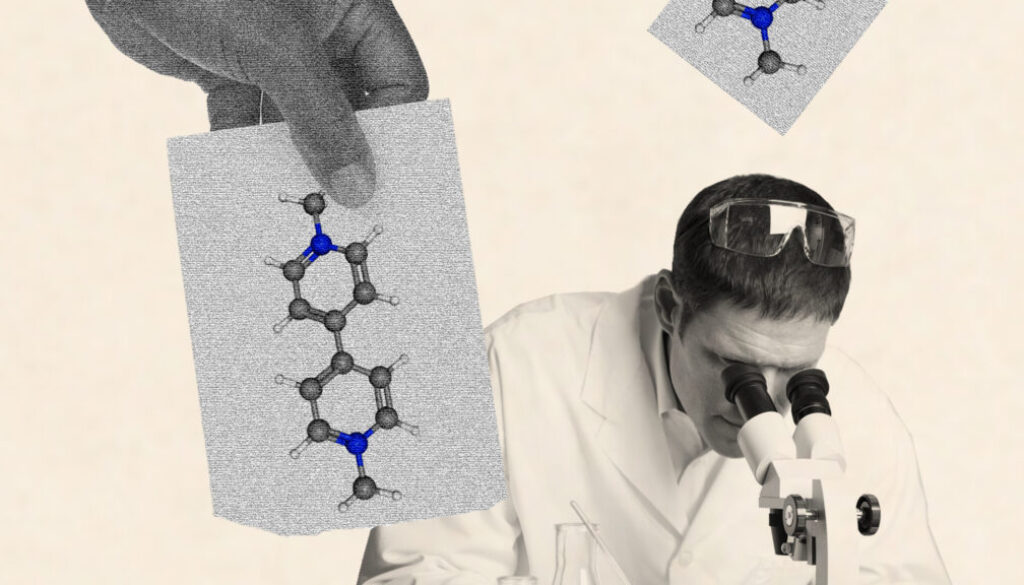Amid calls for ban on weed killer linked to Parkinson’s, a battle over science
When US regulators issued a 2019 assessment of the widely used farm chemical paraquat, they determined that even though multiple scientific studies linked the chemical to Parkinson’s disease, that work was outweighed by other studies that did not find such links. Overall, the weight of scientific evidence was “insufficient” to prove paraquat causes the brain disease, officials with the US Environmental Protection Agency (EPA) declared.
The EPA reiterated its assessment in a 2021 report. The agency said after extensive analysis of numerous factors, including concerns about Parkinson’s risk, it determined farmers could safely continue to apply the weed killer across millions of US acres to help in the production of soybeans, corn, cotton and an array of other crops.
The determination has been significant for Syngenta, the longtime maker of paraquat weed killers. The company is facing calls in the US for a paraquat ban, as well as more than 2,000 legal claims brought by farmers and others alleging they developed Parkinson’s disease because of their exposure to paraquat.
Syngenta cites the EPA assessment of the science on paraquat in defense of the pesticide, and says scientific research “does not support” a causal relationship between the chemical and the disease. On a Syngenta-run paraquat information website, the company highlights several studies it says also backs that position, including many conducted by company scientists or by outside scientists who received company funding for their work.
Last week the Guardian and The New Lede reported that internal corporate records show Syngenta had knowledge of science linking paraquat to Parkinson’s decades ago but sought both to refute the evidence with various secret tactics. The documents are available at the Paraquat Papers Media Library.
US farmworker, health and environmental advocacy groups say in contrast to the corporate science, research conducted by independent scientists provides abundant evidence of paraquat’s ability to cause Parkinson’s and other health dangers, and the EPA is improperly discounting that body of research.
More than 50 groups have called for the US to follow the lead of dozens of other countries in banning paraquat. The Michael J. Fox Foundation for Parkinson’s Research submitted a petition to the EPA with 107,000 signatories calling for a ban. The foundation cited a study that found people exposed to paraquat in their teens or as young adults had an increased Parkinson’s risk of 200 to 600 percent, depending on the overall exposure.
In a 2022 court filing, a contingent of eight such organizations accused the EPA of violating its own risk assessment practices to dismiss what research shows about the connection between paraquat and Parkinson’s. They told the court there is a “substantial body of evidence” of paraquat’s ability to cause Parkinson’s through “chronic low-dose” exposures, along with connections to other health dangers.
“EPA repeatedly understated the extent of paraquat’s adverse effects, and it failed to lawfully address the serious risks it did identify,” the groups stated in their filing with the 9th Circuit Court of Appeals.
Study debate
Parkinson’s is an incurable progressive nervous system disorder that severely limits a person’s ability to control movement. It can cause tremors, loss of balance and eventually often leaves victims bedridden and/or bound to a wheelchair. Parkinson’s symptoms develop when dopamine-producing neurons in the brain degenerate. Without sufficient dopamine production, the brain is not capable of transmitting signals between cells to control movement and balance.
Scientists studying Parkinson’s say research shows genetics play only a small role in causation, and the majority of cases are considered to be triggered by environmental exposures. Along with exposure to paraquat and other pesticides, inhalation of small particles of toxins in polluted air is also seen as a possible cause of the disease. Farmers and farm workers who use pesticides are particularly prone to the disease.
Some of the most debated scientific research when it comes to paraquat and Parkinson’s disease are studies conducted as part of the US Agricultural Health Study (AHS). The AHS started in 1993 as a research project examining the health effects of pesticides on farmers and other pesticide applicators. More than 89,000 farmers and their spouses in Iowa and North Carolina have participated in AHS studies. The project is funded in part by the National Institute of Environmental Health Sciences in collaboration with the EPA.
AHS researchers have published various findings on paraquat and its potential to cause Parkinson’s over the years. In 2011, they reported that study participants who used paraquat or another pesticide called rotenone were twice as likely to develop Parkinson’s disease as people who didn’t use the chemicals.
But in a 2020 update, AHS researchers indicated the results had changed; the findings from 2011 were not replicated. The EPA points to the study as support for its finding of insufficient evidence linking paraquat to Parkinson’s, saying the updated study “reported no association” between paraquat exposure and Parkinson’s disease. And in a statement to the Guardian, Syngenta called the 2020 work “the most comprehensive study of pesticide use and Parkinson’s disease to date.”
Still, critics say the updated study suffered from multiple flaws, including the fact that there was a sizable drop off in the follow-up with study participants. And they point to the fact that even the 2020 AHS researchers acknowledged in their published paper that there were “several limitations” with the study.
And despite the characterization from EPA and Syngenta, the AHS researchers said in their paper that when it comes to paraquat, “animal and earlier human studies offer persuasive evidence for a potential link,” with Parkinson’s. They said they could not rule out the possibility of an association between paraquat and Parkinson’s.
The AHS researchers concluded that continued research on pesticides and Parkinson’s disease with a focus on specific chemicals “is important because of continued widespread use of pesticides worldwide.”
The EPA should not give more weight to the 2020 AHS study than the numerous other studies done over the years, according to a group of three scientists who have filed a brief in federal court joining petitioners in challenging the EPA’s paraquat assessment.
In the court filing, the three scientists- Beate Ritz, co-director of the UCLA Center for Gene-Environment Studies of Parkinson’s disease; Timothy Greenamyre, a neurologist and director of the American Parkinson Disease Association Center for Advanced Research; and Michael Okun, a neuroscientist and director of the Norman Fixel Institute for Neurological Diseases at the University of Florida – said that numerous studies implicated paraquat as a cause for Parkinson’s. (Ritz has been retained as an expert witness for plaintiffs in the litigation against Synenta.)
The scientists said that the EPA had looked at 26 epidemiological studies in its assessment of paraquat and Parkinson’s and all but two of them found positive associations between the pesticide and the disease. Yet the EPA downgraded most of those studies, focusing on the two that did not find an association. The agency similarly improperly dismissed animal studies that found an association, they wrote.
“EPA discounted many important epidemiological and animal studies for reasons that were not sufficiently grounded in science,” the scientists wrote.“Multiple lines of convergent scientific evidence, published in peer-reviewed journals over many years, establish a link between paraquat and Parkinson’s.”
Allegations of a “rigged system”
Critics accuse the EPA of being inappropriately cozy with the pesticide industry, and biasing its decisions to favor companies selling pesticides. Several EPA scientists came forward last year, publicly alleging that EPA management routinely pressures EPA scientists to tamper with risk assessments of chemicals in ways to downplayed the harm the chemicals could pose. The EPA scientists provided emails, text messages, and other records to Congress that their lawyers say demonstrates a “rigged system.” The Office of Inspector General is investigating the complaints.
The scientists complained, among other things, that key managers move back and forth between industry jobs and positions at the EPA. An example is seen in the recent agency review of paraquat.
Records show that one of the EPA officials signing off on the 2019 EPA paraquat assessment had come to the EPA from an industry position. Biologist Kristin Rickard served in 2019 as the acting branch chief for the EPA risk assessment branch evaluating paraquat. Before joining the EPA in 2009, Rickard worked for CropLife America, the powerful Washington-based lobbying organization that represents the pesticide industry.
“One of the most impactful threats to human health from the (EPA) comes from the wide open door between the regulators and industry,” said Nathan Donley, environmental health science director at the Center for Biological Diversity. The nonprofit group is among several organizations challenging the EPA’s paraquat assessment in federal court.
“Croplife’s entire purpose is to get the pesticide industry whatever it wants,” Donley said. “Someone from that world should not be making decisions that have such an enormous impact on public health.”
Rickard now works as a senior scientific evaluator at Health Canada, and did not respond to a request for comment.
California ban sought
In response to the court challenge of its paraquat assessment, the EPA said in late September that it would reconsider “aspects” of its decision to keep paraquat on the market, and would issue an addendum to its assessment within a year.
In the meantime, as they continue to push EPA to ban paraquat, some groups worried about the chemical are also moving to try to convince California to halt its use. As a major agricultural state, a ban in California would set the stage for similar moves in other states, say those seeking a ban.
The Center for Biological Diversity said it will formally be asking the state to reevaluate and ban paraquat ahead of the state’s upcoming annual reapproval of all pesticide ingredients in 2023.
Donley said the decades of internal Syngenta corporate documents recently revealed by The New Lede in a reporting collaboration with the Guardian support the need to halt the use of the weed killer.
“We think there is a pretty compelling case to re-review paraquat because of Parkinson’s disease,” Donley said. “You have to take into account all the evidence, and when you do it paints a pretty clear picture. “
______
(This story is co-published with The Guardian.)
(This work is excluded from Creative Commons CC-BY-NC-ND 4.0 license. Any copy or redistribution in any medium or forum requires express permission by The New Lede.)
 EWG
EWG


